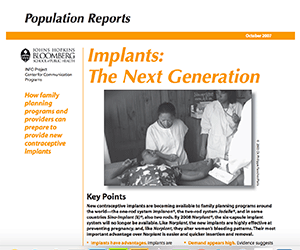The next generation of contraceptive implants offer an extremely effective way to expand family planning choices for women and reduce the incidence of maternal mortality worldwide, according to the latest issue of Population Reports, from the Johns Hopkins Bloomberg School of Public Health.
The new contraceptive implants are matchstick-sized plastic rods inserted just under the skin of a woman’s upper arm. The new one-rod system Implanon, the two-rod system Jadelle, and Sino-Implant (II), another two-rod system available in some countries, will replace Norplant, the original six-capsule contraceptive implant system that will be unavailable after 2008, according to the 20-page Hopkins report.
“Programs may want to add the new implants to their method mix, and programs currently offering Norplant should plan for a transition,” according to co-authors Deepa Ramchandran and Ushma Upadhyay who prepared “Implants: The Next Generation” and its 12-page companion report, “Implants: Tools for Providers.”
The new implants offer the same advantages of the old system, but are easier and quicker to insert and remove and may be lower in price. Once inserted, implants require no action on the part of the client and are one of the most effective ways to prevent pregnancy. Five pregnancies in 10,000 users are expected during the first year of use, compared to 800 pregnancies out of 10,000 users with oral contraceptives.
Evidence suggests that demand for implants is high and that more women would choose implants if they could. Clients express satisfaction with its convenience and long-lasting effectiveness. Depending on the type of implants, they can be effective for three to five years. Fertility returns immediately upon removal. In addition, since implants contain no estrogen (a progestin hormone is released by the rods) they are suitable for breastfeeding women.
A chief concern with first-generation Norplant was its high cost of $27 per set. Of next generation implants, the cheapest is Sino-Implant (II), which has a wholesale price of about US $4.50. While the initial cost of implants is high, they can be cost-effective when used for several years.
Family planning program managers can use the 20-page Population Reports issue to:
- Decide how to adopt the new implants into their method mix
- Prepare their staff to provide the new implants
- Meet the demand for implants by assuring availability and good-quality services.
Health care providers can use the companion issue “Implants: Tools for Providers” to review important elements of providing good-quality services to new and continuing users of implants. It also offers tools for counseling women and helping them to use implants with satisfaction.
In recent months, the INFO Project has directed global attention to two other effective methods with low prevalence in developing countries: the intrauterine device, or IUD, and injectable contraceptives. With the addition of implants, these methods offer women a wider range of contraceptive options to meet their reproductive intentions.
The INFO Project also hosts the Implants Toolkit, a Web site that provides up-to-date and accurate information, resources, and tools related to implants for various audiences. It includes information for providers, trainers, policy makers, program managers, and others. The IUD Toolkit and Injectables Toolkit offer similar resources.
Find These Reports and Related Resources Online:
The full-text version of this Population Reports issue is available at infoforhealth.org/pr/k7/k7.pdf
The full-text version of the INFO Reports companion issue is available at https://www.infoforhealth.org/inforeports/implants/implants.pdf
Highlights of these and other INFO Project publications are also available as PowerPoint Presentations, which you can download and use to prepare talks and presentations, at www.infoforhealth.org/pr/powerpoints.shtml





